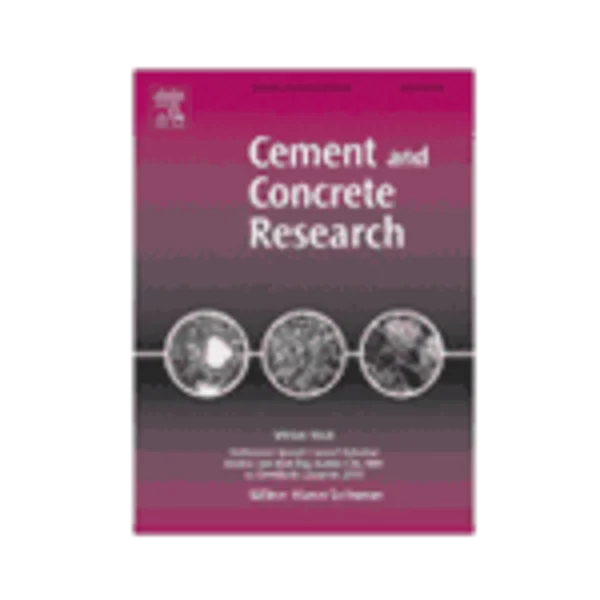-
capillary porosity depercolation in cement-based materials: measurement techniques and factors which influence their interpretation
جزئیات بیشتر مقاله- تاریخ ارائه: 1392/07/24
- تاریخ انتشار در تی پی بین: 1392/07/24
- تعداد بازدید: 992
- تعداد پرسش و پاسخ ها: 0
- شماره تماس دبیرخانه رویداد: -
the connectivity of the capillary porosity in cement-based materials impacts fluid-and-ion transport and thus material durability, the interpretation of experimental measurements such as chemical shrinkage, and the timing and duration of curing operations. while several methods have been used to assess the connectivity of the capillary pores, the interpretation of some experimental procedures can be complicated by the addition of certain chemical admixtures. this paper assesses capillary porosity depercolation in cement pastes using measurements of chemical shrinkage, low temperature calorimetry (ltc), and electrical impedance spectroscopy. the experimental results are analyzed to identify the time of capillary porosity depercolation. in addition, the factors that influence the interpretation of each technique are discussed. experimental evidence suggests that capillary porosity depercolation, as defined by powers, occurs after hydration has reduced the capillary porosity to around 20% in cement paste systems. the influence of capillary porosity depercolation on the transport properties is demonstrated in terms of a reduction in the electrical conductivity of the cementitious material. special attention is paid to understand and interpret the influence of shrinkage-reducing admixtures (sras) on the freezing behavior of cementitious systems, particularly in regard to the inapplicability of using ltc to detect porosity depercolation in cement pastes containing such organic admixtures.
مقالات جدیدترین رویدادها
-
استفاده از تحلیل اهمیت-عملکرد در ارائه الگوی مدیریت خلاقیت سازمانی و ارائه راهکار جهت بهبود
-
بررسی تاثیر ارزش وجوه نقد مازاد بر ساختار سرمایه شرکت های پذیرفته شده در بورس اوراق بهادار تهران
-
بررسی تأثیر سطح افشای ریسک بر قرارداد بدهی شرکت های پذیرفته شده در بورس اوراق بهادار تهران
-
بررسی تأثیر رتبه بندی اعتباری مبتنی بر مدل امتیاز بازار نوظهور بر نقد شوندگی سهام با تأکید بر خصوصی سازی شرکت ها
-
تأثیر آمیخته بازاریابی پوشاک ایرانی بر تصویر ذهنی مشتری پوشاک ایرانی (هاکوپیان)
-
شبیه سازی نرم افزاری رفتار مکانیکی دودکش های بتنی تحت بار انفجارهای هوایی و سطحی
-
بررسی و تحلیل جریان جابجایی آزاد هوا در سیستم گرمایش از کف بر روی حرکت و معلق سازی ذرات ویروس کرونا
-
تاثیر ایده ها و اندیشه های آندره گدار در معماری معاصر ایران
-
mixed monotone iterative technique for a class of semilinear impulsive evolution equations in banach spaces
-
basics of lifestyle interventions in iran: a systematic review
مقالات جدیدترین ژورنال ها
-
مدیریت و بررسی افسردگی دانش آموزان دختر مقطع متوسطه دوم در دروان کرونا در شهرستان دزفول
-
مدیریت و بررسی خرد سیاسی در اندیشه ی فردوسی در ادب ایران
-
واکاوی و مدیریت توصیفی قلمدان(جاکلیدی)ضریح در موزه آستان قدس رضوی
-
بررسی تاثیر خلاقیت، دانش و انگیزه کارکنان بر پیشنهادات نوآورانه کارکنان ( مورد مطالعه: هتل های 3 و 4 ستاره استان کرمان)
-
بررسی تاثیر کیفیت سیستم های اطلاعاتی بر تصمیم گیری موفق در شرکتهای تولیدی استان اصفهان (مورد مطالعه: مدیران شرکتهای تولیدی استان اصفهان)
-
تاثیر سواد بصری بر مصرف علائم و نشانه های مترو توسط مسافران در زندگی روزمره؛ مورد مطالعاتی: سیستم علائم و نشانه های مترو تهران
-
مقایسه روش المان محدود و تفاضل محدود در حل عددی معادله انتشار حرارت یک بعدی
-
تاثیر افق دید مدیریت بر شفافیت شرکتی
-
theoretical study of interaction between mexiletine drug and pristine, si-, ga- and al-doped boron nitride nanosheet
-
vernacular architectural preservation of material and spiritual interconnected cultural heritage




سوال خود را در مورد این مقاله مطرح نمایید :